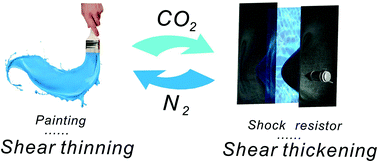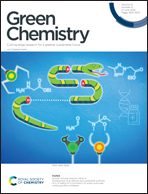CO2-switchable non-Newtonian fluids†
Abstract
Fluidic materials that exhibit an engineered non-Newtonian response are highly desirable in industrial and military applications. For example, shear thickening is highly intriguing in the case of flexible body armor or damping devices; however, shear thinning is more suitable in industrial processes with confining flow or painting. Herein we present a new class of non-Newtonian polymeric fluids with switchable rheological properties being mediated by carbon dioxide (CO2). Several pH-sensitive associative amphiphilic polymers were designed by copolymerizing N,N-dimethylacrylamide (DMA) and N,N-dimethylaminoethyl methacrylate (DMAEMA), followed by hydrophobic modification. In the beginning, polymers carrying an optimal balance of hydrophilic and hydrophobic moieties exhibit shear thinning properties in an alkaline environment. After CO2 aeration, the protonation of tertiary amine groups on the polymer backbone induces coil expansion and promotes interchain cross-linking under shear, leading to an abnormal shear thickening. The fluidic material can regain its shear thinning properties after sparging the solution with N2. Such a gas-controlled process is reversible and clean, which can be performed over multiple cycles. This study taps the potential of CO2 utilization in the dynamic fluidic materials science.



 Please wait while we load your content...
Please wait while we load your content...